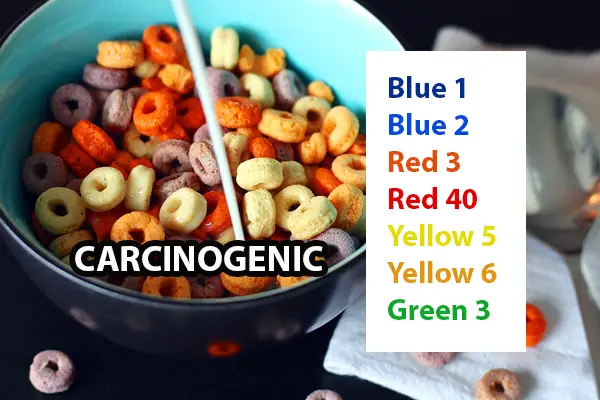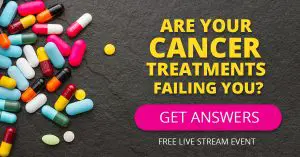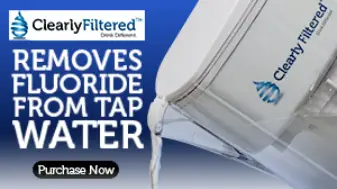
I must have been a strange kid, because the extreme colors of the Rainbow Wonder bread or Superman ice cream did not look appetizing. For many kids across the U.S., however, the bright colors are what attract them to the foods they eat: baked goods, cereal, candies and snacks. And they have no idea the negative health these “foods” will have on them.
Artificial dyes are known to cause hyperactivity and behavioral problems in children, and the United Kingdom has banned a few of the most toxic colorings like Yellow 5, Yellow 6, and Red 40 (other European countries have to put a warning on their labels about potential adverse effects on children). The U.S. is far behind the curve on addressing this health threat; and the problems affect not only children, but the adult population as well with serious risks.
Did you know there can be Yellow 6 in your “cheese products?” Yellow 5 in custard? Red 40 is tomato sauce? Even Red 2 on some unnaturally-bright fresh oranges? The list goes on.
The most dangerous dyes are Blue 1, Blue 2, Red 3, Red 40, Yellow 5, Yellow 6, and Green 3. Some of these are banned for their negative health effects all over the world: Blue 1 is banned in Norway, Finland and France; Yellow 5 and Yellow 6 are banned in Norway.
The danger goes beyond hyperactivity in children – all of these have been shown to cause or increase cancers and tumors in animals.
Seven Most Toxic and Cancer-Causing Food Dyes
Perhaps the most frustrating part to a health-conscious consumer is that whether artificial food colorings carry small or a great risks, why take any risk for an additive with absolutely no benefit? While an argument can be made that many preservatives are toxic, at least they prevent food from getting spoiled thus preventing food poisoning. Food dyes on the other hand offer no tangible benefit for the consumer other than to make them “look pretty.”

American are consuming more food dyes every year. PHOTO: The CSPI
For the manufacturer, however, food dyes are a way to save money. It is a way for General Mills to make the Betty Crocker Carrot Cake Mix…without any pieces of carrots! Instead, they use corn syrup, flour, corn meal, soybean oil (all likely GMOs) and Yellow 6 and Red 40 to make “carrot-flavored pieces.”
Are we really risking a chance of getting cancer for our oranges to look a little more orange? Are we really allowing companies to make colorful fake carrots while we increase our risk of tumors? Because that is exactly what’s happening.
While some argue that it’s the dose that makes the poison, and that the dyes are used at small quantities in each product, it is the accumulative effect of all the hidden dyes in all of the foods that is the main problem. Statistically, Americans today consume five times more food dyes every day than they did in the 1950s. And it’s becoming a real problem.
“These synthetic chemicals do absolutely nothing to improve the nutritional quality or safety of foods, but trigger behavior problems in children and, possibly, cancer in anybody. The Food and Drug Administration should ban dyes, which would force industry to color foods with real food ingredients, not toxic petrochemicals,” said The Center for Science in the Public Interest (CSPI) Executive Director Michael Jacobsen.
Out of all the dyes, there are seven that you need to be especially cautions of: Blue 1 and Blue 2, Red 3 and Red 40, Yellow 5 and Yellow 6, and Green 3. All can be found in a variety of foods.
Blue #1 (Brilliant Blue) is most often found in raspberry-flavored snacks. It is also used in Gatorade, Kellogg’s Blueberry Cereal Bars, canned peas, dairy products, baked goods, beverages, and many cereals. But it’s not just food you need to worry about. Brilliant Blue is also added to mouthwash, soaps, shampoos, and cosmetics. With these products, the dye is absorbed by the skin and ends up in the person’s bloodstream. Risks: Blue 1 has caused allergic reactions, especially in people who have asthma. One study also showed that the dye was responsible for kidney tumors in laboratory mice.
Blue #2 (Indigo Carmine) can be found in candies, baked goods, pet food, ice cream, snacks, and cherries. Risks: Besides causing hyperactivity in children, it caused brain and bladder tumors in rats.
Red #3 (Erythrosine) is used to color maraschino cherries, baked goods, candy, popsicles, and even pistachio shells in Blue Diamond nut mix. Risks: Because there was a study that showed Red 3 causes thyroid tumors when used externally, it was banned by the FDA to be used in cosmetics and topical medications. It is still used in foods today, even though another study showed that Red 3 may promote thyroid tumor formation when used internally as well.

Rainbow Wonder Bread is guilty of using all of the food dyes in one product. PHOTO: Pinterest
Red #40 (Allura Red) is used in many products: cereals, desserts, drugs, cosmetics, fruit cocktail, maraschino cherries, grenadine, cherry pie mix, ice cream, and even Kraft Ketchup. Risks: Until 1976 Red #2 was used in places where today we see Red #40. Red 2 was suspected as carcinogenic, and replaced (although still used on the peel of some oranges), but its substitute Red 40 has its own cancer risks.
“Red #40 may contain the carcinogenic contaminant p-Cresidine and is thought to cause tumors of the immune system,” write the authors of “Rich Food Poor Food,” Jayson and Mira Calton.
Yellow #5 (Tartrazine) is most known for giving Mountain Dew its neon glow. It is also found in Kraft Macaroni & Cheese, Doritos, Peeps marshmallows, energy drinks, gum, popcorn, jelly, mustard, horseradish, pickles, rice, noodles, seaweed, salad, baked goods, cereal, gelatin products, dessert powders; and many cosmetics, hygiene products, and drugs. Risks: In 1986 FDA’s committee concluded that some people (under 1 in 10,000) develop hives and swelling from Yellow 5, and the ingredient had to be legally put on the label. This food dye also causes severe hypersensitivity and may trigger hyperactivity and behavioral issues in children. Yellow 5 carries a compound benzidine, which is a carcinogen. Six studies showed that it causes genotoxicity, which can cause DNA mutilation leading to cancer.
Yellow #6 (Sunset yellow) is found in beverages, desserts, gelatin, candy, fruit preserves, chocolate, caramel, sauces, and sausages. Risks: Studies have found that Yellow 6 can cause adrenal and testicular tumors in rats, and also trigger severe hyperactivity in children.
Green #3 (Fast green) is used in preserved green peas and green vegetables, sauces, fish, desserts, candy, cosmetics and drugs. Risks: Research showed increases in tumors of the bladder and testes in male rats. It was also found to have a mutagenic effect in experimental studies on animals and humans.
Virtually all of the studies done on the food dyes looked at the effects of each dye individually, and did not take into the account what happens to the body when multiple different artificial colorings are consumed daily, reported the Center for Science in the Public Interest in its report “Food Dyes: A Rainbow of Risks.”
While there have not been enough studies done for the FDA to ban all these dyes, why take the risk, when there are natural alternatives?
There Is a Solution! Natural Dyes That Can Be SAFELY Used Instead.
“Until the twentieth century, food coloring was obtained from natural sources,” the Caltons write. “People gathered spices, like saffron and turmeric, to add rich hues to their otherwise bland-colored foods.”
When there is a will, there is a way, and if we as consumers refused to buy food with artificial colorings, the food companies would have to find alternatives.
While the alternatives are not quite as bright, we can all learn to love the color our food was meant to have by nature.
These natural dyes are already used by some health-conscious companies, such as India Tree natural coloring supplies. The colors are derived from vegetables, berries, and spices.
Berries can replace Blue 1 and Blue 2; beets and paprika can substitute Red 3 and Red 40; turmeric and saffron can be used instead of Yellow 5 and Yellow 6; and spinach can swap Green 3.
All that is needed is for the FDA to ban food dyes altogether, and the food manufacturing process would finally begin to change.
SIGN a Petition: The CSPI started one of many petitions found around the web on Change.org. At the time of writing this article the petition has 102,411 supporting it, with a goal of 150,000. You can help by singing it here.
Want to learn more about the most effective ways to prevent and beat cancer? Watch the Truth About Cancer, a 9-part documentary NOW.
Recommended reading:
This is What Happens to Kids’ Bodies When They Consume Artificial Food Dyes
Mars Will Remove Artificial Dyes from Their Products – But It May Be Too Early to Celebrate
Thanks for installing the Bottom of every post plugin by Corey Salzano. Contact me if you need custom WordPress plugins or website design.





